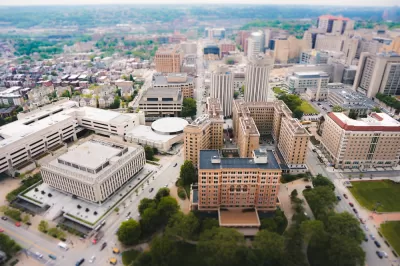The implementation of a new master plan for the neighborhood of Oakland, home to the University of Pittsburgh, is moving forward despite controversy and a contentious community engagement process.

On February 22, the city of Pittsburgh gave preliminary approval to a package of zoning changes, including new zones for mixed-use development as well as residential and office development, for the Oakland neighborhood. The changes do not represent a massive upzoning effort, however, as indicated by some of the opposition to the zoning changes, according to an article by Mark Belko for the Pittsburgh Post-Gazette.
David Vatz, chapter lead of Pro-Housing Pittsburgh, a nonprofit that advocates for abundant and affordable housing, is quoted in the article criticizing the reduction of allowed building heights in one of the zoning changes. “I think what we would love to see for Oakland is it zoned for a ton of growth and a ton of housing. I don’t think they’ve really done that,” says Vatz in the article, adding, “We’d really like to see some leadership from the [Mayor Gainey] administration and council to really zoning these areas for new housing.”
According to Belko, the rezoning will implement the Oakland Plan, a ten-year master plan for the neighborhood approved in June 2022. Additional news coverage of the zoning implementation of the Oakland Plan is available from Pittsburgh City Paper and WESA. The coverage for WESA, written by Margaret J. Krauss, provides these descriptions of the three new zoning districts that will implement the Oakland Plan:
- “Urban Center-Employment (UCE) would cover an area that includes the Fifth and Forbes Avenues corridor and a piece of Boulevard of the Allies bordered by Craft Avenue. It aims to “support life sciences, health care,” and other employment engines. Neighborhood-serving businesses are also encouraged on the ground floor. The proposed language emphasizes transit and, where parking is needed, sharing it between different building owners. Buildings would have to be at least 40 feet tall, but could reach a maximum height of between 85 and 210 feet, depending on location.”
- “Urban Center-Mixed Use (UCMU) would cover an area clustered around Boulevard of the Allies as it moves east toward Schenley Park. Buildings here would have to be at least 24 feet tall, but could reach a maximum height of between 65 and 185 feet, depending on location. The zoning rules are an effort to encourage the development of small businesses and commercial uses for the neighborhood, along with affordable and workforce housing.”
- “Residential-Mixed Use (RMU) would cover much of Central Oakland. It aims to create new housing, both through the restoration of historic homes and the creation of new apartment buildings. Retail space is also encouraged. Buildings here would have to be at least 24 feet tall, but could reach a maximum of between 40 and 95 feet, depending on location.”

Maui's Vacation Rental Debate Turns Ugly
Verbal attacks, misinformation campaigns and fistfights plague a high-stakes debate to convert thousands of vacation rentals into long-term housing.

Planetizen Federal Action Tracker
A weekly monitor of how Trump’s orders and actions are impacting planners and planning in America.

In Urban Planning, AI Prompting Could be the New Design Thinking
Creativity has long been key to great urban design. What if we see AI as our new creative partner?

King County Supportive Housing Program Offers Hope for Unhoused Residents
The county is taking a ‘Housing First’ approach that prioritizes getting people into housing, then offering wraparound supportive services.

Researchers Use AI to Get Clearer Picture of US Housing
Analysts are using artificial intelligence to supercharge their research by allowing them to comb through data faster. Though these AI tools can be error prone, they save time and housing researchers are optimistic about the future.

Making Shared Micromobility More Inclusive
Cities and shared mobility system operators can do more to include people with disabilities in planning and operations, per a new report.
Urban Design for Planners 1: Software Tools
This six-course series explores essential urban design concepts using open source software and equips planners with the tools they need to participate fully in the urban design process.
Planning for Universal Design
Learn the tools for implementing Universal Design in planning regulations.
planning NEXT
Appalachian Highlands Housing Partners
Gallatin County Department of Planning & Community Development
Mpact (founded as Rail~Volution)
City of Camden Redevelopment Agency
City of Astoria
City of Portland
City of Laramie




























